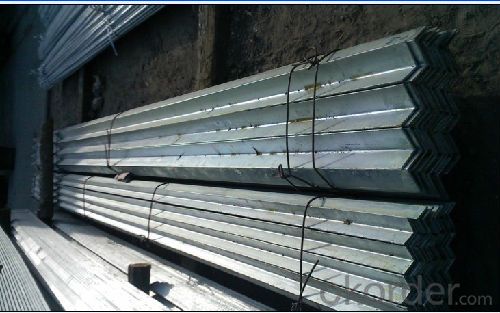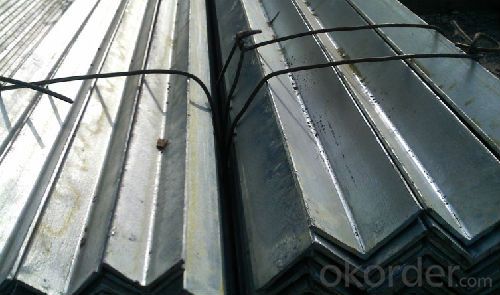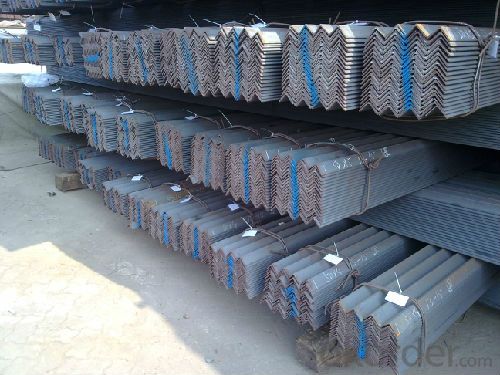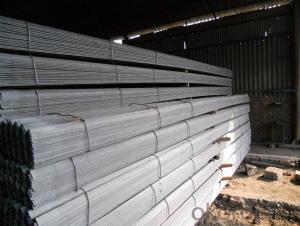Hot Rolled Steel Angle Q235, A36,SS400 for Strcuture
- Loading Port:
- Tianjin
- Payment Terms:
- TT or LC
- Min Order Qty:
- 25 m.t.
- Supply Capability:
- 200000 m.t./month
OKorder Service Pledge
OKorder Financial Service
You Might Also Like
Product Description:
Specifications of Hot Rolled Steel Angle Q235, A36,SS400 for Strcuture
1. Invoicing on theoretical weight or actual weight as customer request
2. Length: 6m, 9m, 12m as following table
3. Sizes
Sizes: 25mm-250mm | ||
a*t | ||
25*2.5-4.0 | 70*6.0-9.0 | 130*9.0-15 |
30*2.5-6.6 | 75*6.0-9.0 | 140*10-14 |
36*3.0-5.0 | 80*5.0-10 | 150*10-20 |
38*2.3-6.0 | 90*7.0-10 | 160*10-16 |
40*3.0-5.0 | 100*6.0-12 | 175*12-15 |
45*4.0-6.0 | 110*8.0-10 | 180*12-18 |
50*4.0-6.0 | 120*6.0-15 | 200*14-25 |
60*4.0-8.0 | 125*8.0-14 | 250*25 |
5. Payment terms:
1).100% irrevocable L/C at sight.
2).30% T/T prepaid and the balance against the copy of B/L.
3).30% T/T prepaid and the balance against L/C
6.Material details:
Alloy No | Grade | Element (%) | |||||
C | Mn | S | P | Si | |||
Q235 | B | 0.12—0.20 | 0.3—0.7 | ≤0.045 | ≤0.045 | ≤0.3 | |
Alloy No | Grade | Yielding strength point( Mpa) | |||||
Thickness (mm) | |||||||
≤16 | >16--40 | >40--60 | >60--100 | ||||
≥ | |||||||
Q235 | B | 235 | 225 | 215 | 205 | ||
Alloy No | Grade | Tensile strength (Mpa) | Elongation after fracture (%) | ||||
Thickness (mm) | |||||||
≤16 | >16--40 | >40--60 | >60--100 | ||||
≥ | |||||||
Q235 | B | 375--500 | 26 | 25 | 24 | 23 | |
Usage & Applications of Hot Rolled Steel Angle Q235, A36,SS400 for Strcuture
According to the needs of different structures, Angle can compose to different force support component, and also can be the connections between components. It is widely used in various building structures and engineering structures such as roof beams, bridges, transmission towers, hoisting machinery and transport machinery, ships, industrial furnaces, reaction tower, container frame and warehouse etc.
Packaging & Delivery of Hot Rolled Steel Angle Q235, A36,SS400 for Strcuture
1. Packing: it is nude packed in bundles by steel wire rod
2. Bundle weight: not more than 3.5MT for bulk vessel; less than 3 MT for container load
3. Marks:
Color marking: There will be color marking on both end of the bundle for the cargo delivered by bulk vessel. That makes it easily to distinguish at the destination port.
Tag mark: there will be tag mark tied up on the bundles. The information usually including supplier logo and name, product name, made in China, shipping marks and other information request by the customer.
If loading by container the marking is not needed, but we will prepare it as customer request.
Production flow of Hot Rolled Steel Angle Q235, A36,SS400 for Strcuture
Material prepare (billet) —heat up—rough rolling—precision rolling—cooling—packing—storage and transportation
Images of Hot Rolled Steel Angle Q235, A36,SS400 for Strcuture



- Q:Can steel angles be used in mezzanine construction?
- Certainly! Steel angles hold the potential to be utilized in mezzanine construction. Owing to their robustness and adaptability, steel angles are frequently employed as foundational components in construction. Within mezzanine construction, these steel angles can be employed as framing elements to uphold the floor or platform of the mezzanine. Additionally, they can be employed to establish the structure for the stairs or railing systems. By contributing stability and support to the mezzanine structure, steel angles have gained popularity as a favored option in this form of construction.
- Q:Can steel angles be used for pipe supports or hangers?
- Yes, steel angles can be used for pipe supports or hangers. Steel angles provide structural support and stability for pipes, making them suitable for various applications in the construction and industrial sectors. The L-shape design of steel angles allows for easy attachment to walls, ceilings, or other structural members, providing a sturdy base for suspending or supporting pipes. Additionally, the strength and durability of steel angles make them capable of withstanding the weight and pressure exerted by the pipes, ensuring long-term stability and reliability. Overall, steel angles are a commonly used and effective choice for pipe supports and hangers.
- Q:Can steel angles be painted or coated?
- Yes, steel angles can be painted or coated. Painting or coating steel angles can provide several benefits such as protection against corrosion, enhanced aesthetics, and improved durability. Prior to painting or coating, it is important to properly clean and prepare the surface of the steel angles to ensure good adhesion of the paint or coating. This typically involves removing any rust, grease, or dirt, and applying a suitable primer. Once the surface is properly prepared, a variety of paints or coatings can be applied, such as epoxy, polyurethane, or powder coatings. The choice of paint or coating will depend on the specific requirements of the application, such as the level of corrosion resistance or desired appearance. Overall, painting or coating steel angles is a common practice to enhance their performance and prolong their lifespan.
- Q:Can galvanized square tubes and angle iron be welded together?
- Yes, if the requirement is not high, it can be welded directly. If the requirement is high, the zinc coating on the galvanized square pipe can be polished off before welding, and then welded. However, two kinds of welding methods, welding well, must be carried out at the weld corrosion. Now there is a special coating for hot-dip galvanizing on the market. It is characterized by high zinc content and 96% zinc content. It can provide similar anticorrosive effect to hot-dip galvanizing for repairing parts.
- Q:What is the process of cold bending steel angles?
- The process of cold bending steel angles involves using hydraulic or mechanical forces to gradually shape the steel angle into a desired curve or angle without the use of heat. This is achieved by carefully manipulating and applying pressure to the steel angle until it is bent to the desired shape.
- Q:How do you determine the required number of steel angles for a project?
- Determining the required number of steel angles for a project involves considering several factors. Firstly, it is important to understand the design and specifications of the project. This includes the structural requirements, load-bearing capacities, and any specific angles or dimensions that need to be incorporated. Secondly, the dimensions of the steel angles need to be determined based on the intended use and structural requirements. This includes considering the length, width, and thickness of the angles that would be suitable for the project. Once the dimensions are established, the next step is to calculate the number of angles required. This can be done by carefully measuring and estimating the lengths of the steel angles needed in each area of the project. It is important to consider any potential waste or additional cuts that may be required during the installation process. In addition, it is recommended to consult with structural engineers or professionals experienced in steel fabrication to ensure accurate calculations and to confirm that the selected steel angles meet the necessary safety standards and building codes. Ultimately, determining the required number of steel angles for a project requires a combination of careful planning, accurate measurements, and professional expertise to ensure the project is structurally sound and meets all necessary requirements.
- Q:Can steel angles be used for shelving and storage racks?
- Indeed, shelving and storage racks can utilize steel angles. Given their robustness and endurance, steel angles are widely employed in construction and engineering. They offer exceptional structural reinforcement and are capable of withstanding substantial loads, making them a perfect fit for shelving and storage racks. By virtue of their easy fabrication and weldability, steel angles can be effortlessly joined together to create desired designs for shelving or storage racks. Moreover, they come in various dimensions and thicknesses, allowing for customization to meet specific storage requirements. Furthermore, steel angles exhibit resistance against corrosion, making them highly advantageous in environments where moisture or chemicals are prevalent. All in all, steel angles are a reliable and versatile option when it comes to shelving and storage racks.
- Q:Can steel angles be used for building frames?
- Indeed, the utilization of steel angles is feasible when constructing frames. In the realm of construction, steel angles are frequently employed for framing purposes owing to their robustness and adaptability. They are commonly utilized in the formation of the structural skeleton of edifices, such as the construction of walls, floors, and roofs. Steel angles furnish stability and support to the overall structure and can be effortlessly welded or bolted together to fabricate a sturdy and enduring frame. Moreover, steel angles are obtainable in a variety of sizes and thicknesses, allowing for customization and adaptation to diverse building requisites. All in all, steel angles are a favored option for constructing frames due to their strength, versatility, and user-friendly nature.
- Q:What are the different types of steel coatings available for angles?
- There are several different types of steel coatings available for angles, each with its own unique characteristics and benefits. Some of the most common types include: 1. Galvanized coating: This is one of the most popular and widely used types of steel coating for angles. Galvanization involves applying a layer of zinc to the surface of the steel, providing excellent corrosion resistance. Galvanized angles are commonly used in outdoor applications or in environments where moisture and humidity are present. 2. Powder coating: Powder coating is a type of dry finishing process that involves applying a fine powder to the surface of the steel angles. The powder is electrostatically charged and adheres to the metal, creating a smooth, durable, and attractive finish. Powder coating provides excellent resistance to scratches, chipping, and fading, making it a popular choice for decorative or architectural applications. 3. Epoxy coating: Epoxy coatings are a type of thermosetting polymer that is applied to the surface of the steel angles. These coatings provide exceptional resistance to chemicals, corrosion, and abrasion, making them suitable for harsh and demanding environments. Epoxy-coated angles are commonly used in industrial settings, such as chemical plants or wastewater treatment facilities. 4. Paint coating: Paint coatings are a traditional and cost-effective option for steel angles. They are typically applied as a liquid and can be customized in terms of color and finish. While paint coatings provide some level of protection against corrosion, they may not be as durable or long-lasting as other types of coatings. However, they can still be suitable for indoor or low-corrosion applications. 5. Organic coating: Organic coatings, such as polyurethane or polyester, are often used to provide a decorative or protective layer to steel angles. These coatings offer excellent resistance to UV radiation, weathering, and fading, making them suitable for outdoor applications. Organic-coated angles can be found in architectural, construction, or infrastructure projects. It's important to consider the specific requirements of your application when choosing a steel coating for angles. Factors such as environmental conditions, aesthetic preferences, and durability needs should all be taken into account to ensure the proper selection of the coating that best suits your project.
- Q:Can steel angles be used for architectural detailing?
- Yes, steel angles can be used for architectural detailing. Steel angles are versatile structural elements that can be used in various architectural applications. They provide stability and support to structures and can be used for framing, bracing, and reinforcing purposes. Steel angles can be seen in architectural details such as window frames, door frames, staircases, and handrails, among others. They offer strength and durability, making them suitable for both interior and exterior architectural designs. Additionally, steel angles can be easily customized and fabricated to meet specific design requirements, allowing architects to create unique and aesthetically pleasing architectural details.
1. Manufacturer Overview |
|
|---|---|
| Location | |
| Year Established | |
| Annual Output Value | |
| Main Markets | |
| Company Certifications | |
2. Manufacturer Certificates |
|
|---|---|
| a) Certification Name | |
| Range | |
| Reference | |
| Validity Period | |
3. Manufacturer Capability |
|
|---|---|
| a)Trade Capacity | |
| Nearest Port | |
| Export Percentage | |
| No.of Employees in Trade Department | |
| Language Spoken: | |
| b)Factory Information | |
| Factory Size: | |
| No. of Production Lines | |
| Contract Manufacturing | |
| Product Price Range | |
Send your message to us
Hot Rolled Steel Angle Q235, A36,SS400 for Strcuture
- Loading Port:
- Tianjin
- Payment Terms:
- TT or LC
- Min Order Qty:
- 25 m.t.
- Supply Capability:
- 200000 m.t./month
OKorder Service Pledge
OKorder Financial Service
Similar products
New products
Hot products
Related keywords


























